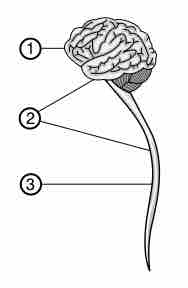Introduction to the Central Nervous System
The central nervous system (CNS) is one of the two major subdivisions of the nervous system. The CNS includes the brain and spinal cord, which together comprise the body's main control center. Together with the peripheral nervous system (PNS), the CNS performs fundamental functions that contribute to an organism's life and behavior.
Activity of the CNS
The nervous system has three main functions: gathering sensory information from external stimuli, synthesizing that information, and responding to those stimuli. The CNS is mainly devoted to the "information synthesizing" function. During this step in the process, the brain and spinal cord decide on appropriate motor output, which is computed based on the type of sensory input. The CNS regulates everything from organ function to high-level thought to purposeful body movement. Thus, the CNS is commonly thought of as the control center of the body.
Structure of the Central Nervous System
The CNS is comprised of the brain, brain stem, and spinal cord.

The central nervous system
The three major components of the central nervous system: 1) the brain, 2) brain stem, and 3) spinal cord.
Brain
The brain is found in the cranial cavity and consists of the cerebrum and cerebellum. It houses the nerve centers responsible for coordinating sensory and motor systems in the body. The cerebrum, or the top portion for the brain, is the seat of higher-level thought. It is comprised of two hemispheres, each controlling the opposite side of the body. Each of these hemispheres is divided into four separate lobes:
- the frontal lobe, which controls specialized motor control, learning, planning, and speech;
- the parietal lobe, which controls somatic or voluntary sensory functions;
- the occipital lobe, which controls vision;
- the temporal lobe, which controls hearing and some other speech functions.
The cerebellum is located underneath the backside of the cerebrum, and governs balance and fine motor movements. Its main function is maintaining coordination throughout the body.
Brain Stem
The brain stem is connected to the underside of the brain. It consists of the midbrain, pons, and medulla. The midbrain is found in between the hindbrain and the forebrain. It regulates motor function and allows motor and sensory information to pass from the brain to the rest of the body. The pons houses the control centers for respiration and inhibitory functions. The medulla also helps regulate respiration, as well as cardiovascular and digestive functioning.
Spinal Cord
The spinal cord connects the brain and brain stem to all of the major nerves in the body. Spinal nerves originate from the spinal cord and control the functions of the rest of the body. Impulses are sent from receptors through the spinal cord to the brain, where they are processed and synthesized into instructions for the rest of the body. This data is then sent back through the spinal cord to muscles and glands for motor output.